Report on Effective Reporting and Record Keeping in Healthcare
VerifiedAdded on 2020/10/22
|7
|1046
|173
Report
AI Summary
This report analyzes effective reporting and record-keeping practices within health and social care, focusing on the legal and practical aspects of maintaining patient records. It examines the implementation of record-keeping systems, such as those used at Surrey and Sussex hospital, and the importance of different record formats for various service users, including elderly patients, children, and critical patients. The report highlights the significance of clarity, conciseness, and completeness in record-keeping, as well as the role of software and administrative units. It delves into the legal obligations, referencing the Public Record Act 1958 and the Freedom of Information Act 2000, and explores the importance of staff training and computerized patient records. The report concludes by emphasizing the need to adhere to all legal and statutory requirements, including the Data Protection Act 1998, for effective health record maintenance and reporting.
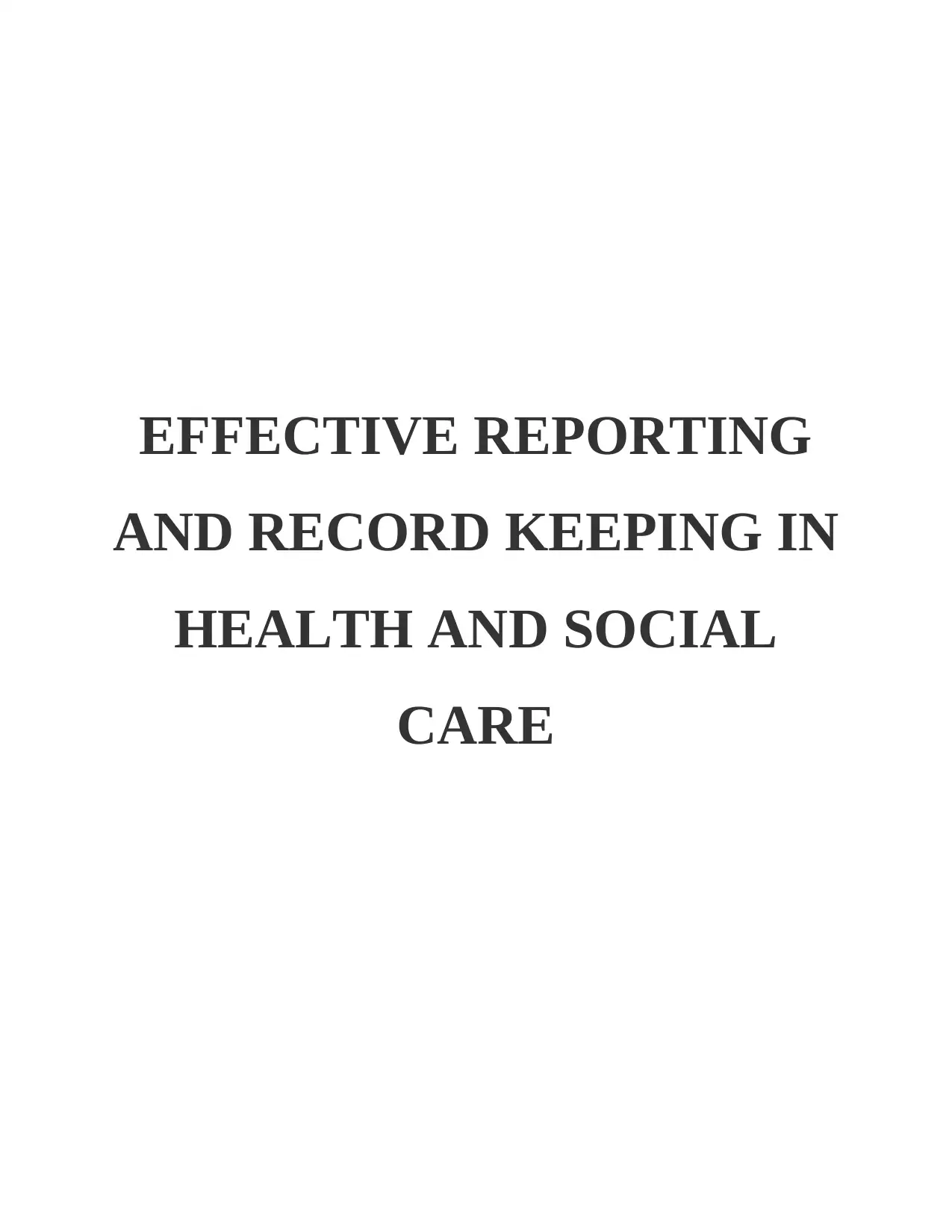
EFFECTIVE REPORTING
AND RECORD KEEPING IN
HEALTH AND SOCIAL
CARE
AND RECORD KEEPING IN
HEALTH AND SOCIAL
CARE
Paraphrase This Document
Need a fresh take? Get an instant paraphrase of this document with our AI Paraphraser
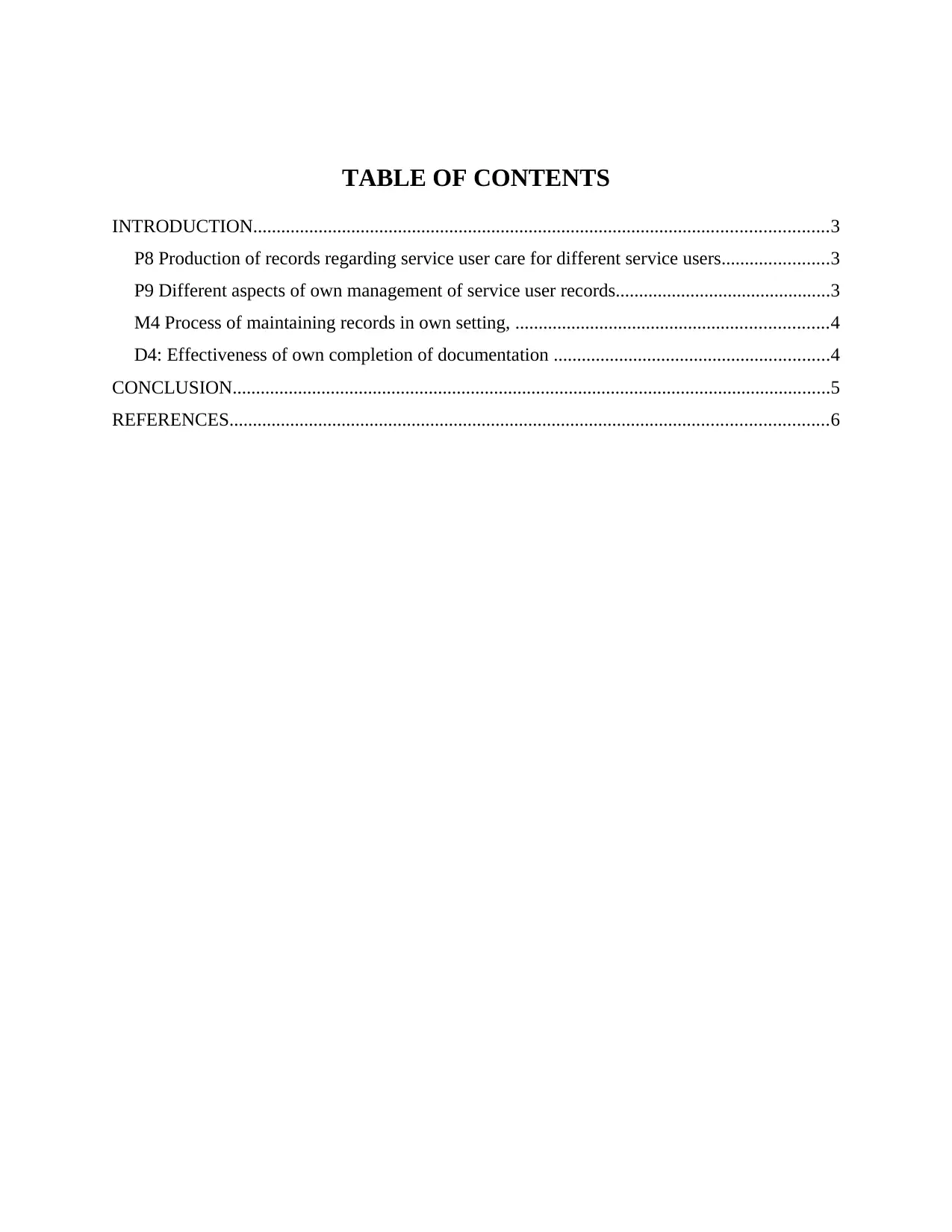
TABLE OF CONTENTS
INTRODUCTION...........................................................................................................................3
P8 Production of records regarding service user care for different service users.......................3
P9 Different aspects of own management of service user records..............................................3
M4 Process of maintaining records in own setting, ...................................................................4
D4: Effectiveness of own completion of documentation ...........................................................4
CONCLUSION................................................................................................................................5
REFERENCES................................................................................................................................6
INTRODUCTION...........................................................................................................................3
P8 Production of records regarding service user care for different service users.......................3
P9 Different aspects of own management of service user records..............................................3
M4 Process of maintaining records in own setting, ...................................................................4
D4: Effectiveness of own completion of documentation ...........................................................4
CONCLUSION................................................................................................................................5
REFERENCES................................................................................................................................6
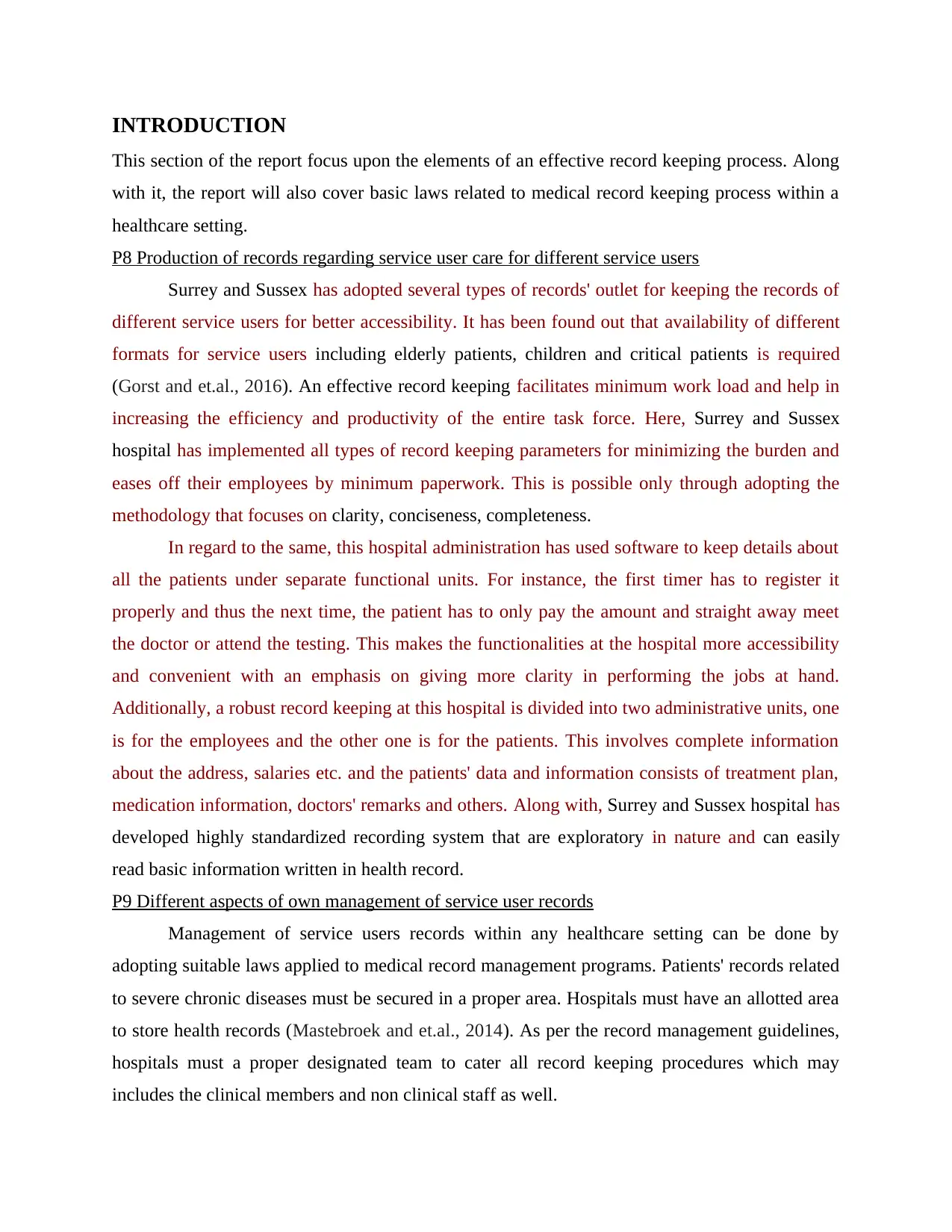
INTRODUCTION
This section of the report focus upon the elements of an effective record keeping process. Along
with it, the report will also cover basic laws related to medical record keeping process within a
healthcare setting.
P8 Production of records regarding service user care for different service users
Surrey and Sussex has adopted several types of records' outlet for keeping the records of
different service users for better accessibility. It has been found out that availability of different
formats for service users including elderly patients, children and critical patients is required
(Gorst and et.al., 2016). An effective record keeping facilitates minimum work load and help in
increasing the efficiency and productivity of the entire task force. Here, Surrey and Sussex
hospital has implemented all types of record keeping parameters for minimizing the burden and
eases off their employees by minimum paperwork. This is possible only through adopting the
methodology that focuses on clarity, conciseness, completeness.
In regard to the same, this hospital administration has used software to keep details about
all the patients under separate functional units. For instance, the first timer has to register it
properly and thus the next time, the patient has to only pay the amount and straight away meet
the doctor or attend the testing. This makes the functionalities at the hospital more accessibility
and convenient with an emphasis on giving more clarity in performing the jobs at hand.
Additionally, a robust record keeping at this hospital is divided into two administrative units, one
is for the employees and the other one is for the patients. This involves complete information
about the address, salaries etc. and the patients' data and information consists of treatment plan,
medication information, doctors' remarks and others. Along with, Surrey and Sussex hospital has
developed highly standardized recording system that are exploratory in nature and can easily
read basic information written in health record.
P9 Different aspects of own management of service user records
Management of service users records within any healthcare setting can be done by
adopting suitable laws applied to medical record management programs. Patients' records related
to severe chronic diseases must be secured in a proper area. Hospitals must have an allotted area
to store health records (Mastebroek and et.al., 2014). As per the record management guidelines,
hospitals must a proper designated team to cater all record keeping procedures which may
includes the clinical members and non clinical staff as well.
This section of the report focus upon the elements of an effective record keeping process. Along
with it, the report will also cover basic laws related to medical record keeping process within a
healthcare setting.
P8 Production of records regarding service user care for different service users
Surrey and Sussex has adopted several types of records' outlet for keeping the records of
different service users for better accessibility. It has been found out that availability of different
formats for service users including elderly patients, children and critical patients is required
(Gorst and et.al., 2016). An effective record keeping facilitates minimum work load and help in
increasing the efficiency and productivity of the entire task force. Here, Surrey and Sussex
hospital has implemented all types of record keeping parameters for minimizing the burden and
eases off their employees by minimum paperwork. This is possible only through adopting the
methodology that focuses on clarity, conciseness, completeness.
In regard to the same, this hospital administration has used software to keep details about
all the patients under separate functional units. For instance, the first timer has to register it
properly and thus the next time, the patient has to only pay the amount and straight away meet
the doctor or attend the testing. This makes the functionalities at the hospital more accessibility
and convenient with an emphasis on giving more clarity in performing the jobs at hand.
Additionally, a robust record keeping at this hospital is divided into two administrative units, one
is for the employees and the other one is for the patients. This involves complete information
about the address, salaries etc. and the patients' data and information consists of treatment plan,
medication information, doctors' remarks and others. Along with, Surrey and Sussex hospital has
developed highly standardized recording system that are exploratory in nature and can easily
read basic information written in health record.
P9 Different aspects of own management of service user records
Management of service users records within any healthcare setting can be done by
adopting suitable laws applied to medical record management programs. Patients' records related
to severe chronic diseases must be secured in a proper area. Hospitals must have an allotted area
to store health records (Mastebroek and et.al., 2014). As per the record management guidelines,
hospitals must a proper designated team to cater all record keeping procedures which may
includes the clinical members and non clinical staff as well.
⊘ This is a preview!⊘
Do you want full access?
Subscribe today to unlock all pages.

Trusted by 1+ million students worldwide
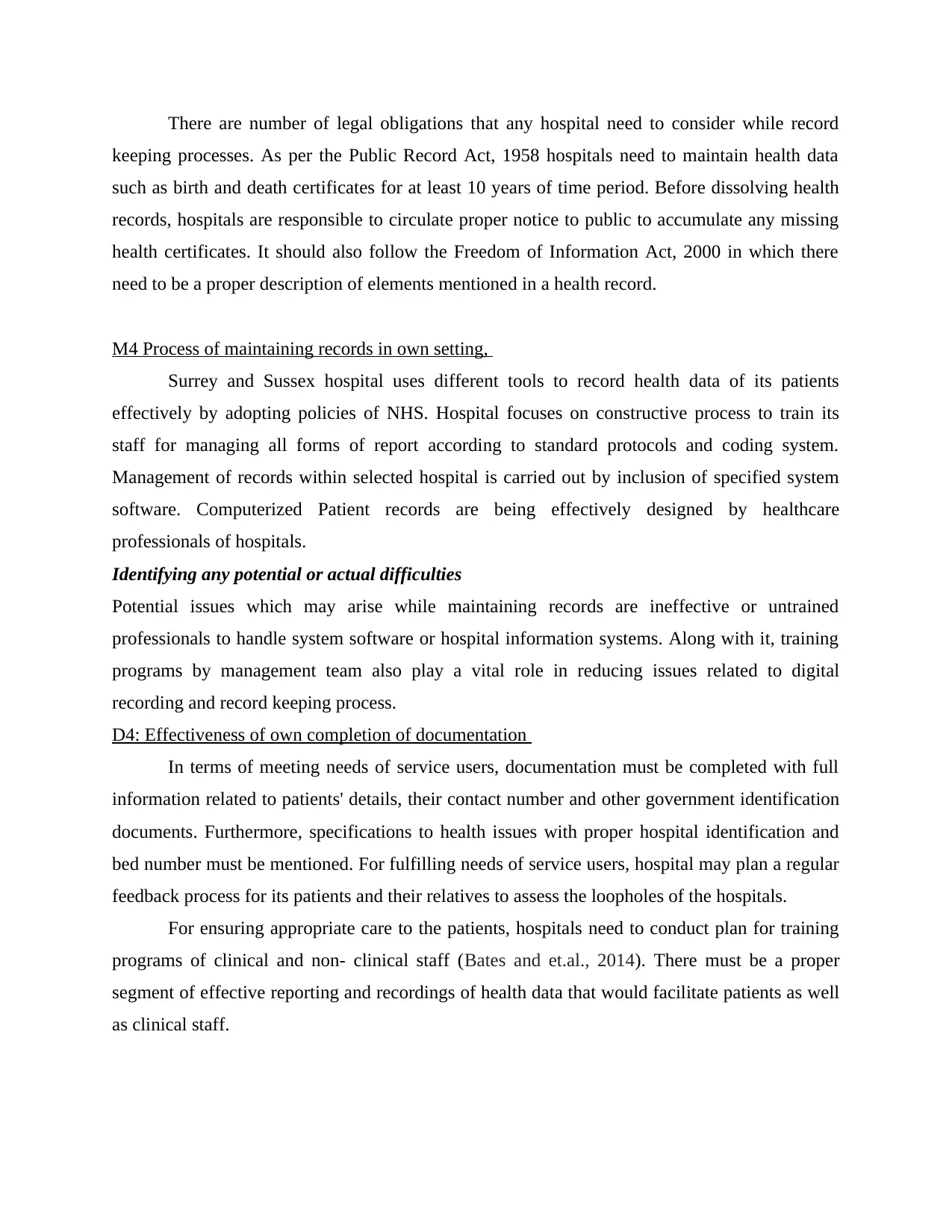
There are number of legal obligations that any hospital need to consider while record
keeping processes. As per the Public Record Act, 1958 hospitals need to maintain health data
such as birth and death certificates for at least 10 years of time period. Before dissolving health
records, hospitals are responsible to circulate proper notice to public to accumulate any missing
health certificates. It should also follow the Freedom of Information Act, 2000 in which there
need to be a proper description of elements mentioned in a health record.
M4 Process of maintaining records in own setting,
Surrey and Sussex hospital uses different tools to record health data of its patients
effectively by adopting policies of NHS. Hospital focuses on constructive process to train its
staff for managing all forms of report according to standard protocols and coding system.
Management of records within selected hospital is carried out by inclusion of specified system
software. Computerized Patient records are being effectively designed by healthcare
professionals of hospitals.
Identifying any potential or actual difficulties
Potential issues which may arise while maintaining records are ineffective or untrained
professionals to handle system software or hospital information systems. Along with it, training
programs by management team also play a vital role in reducing issues related to digital
recording and record keeping process.
D4: Effectiveness of own completion of documentation
In terms of meeting needs of service users, documentation must be completed with full
information related to patients' details, their contact number and other government identification
documents. Furthermore, specifications to health issues with proper hospital identification and
bed number must be mentioned. For fulfilling needs of service users, hospital may plan a regular
feedback process for its patients and their relatives to assess the loopholes of the hospitals.
For ensuring appropriate care to the patients, hospitals need to conduct plan for training
programs of clinical and non- clinical staff (Bates and et.al., 2014). There must be a proper
segment of effective reporting and recordings of health data that would facilitate patients as well
as clinical staff.
keeping processes. As per the Public Record Act, 1958 hospitals need to maintain health data
such as birth and death certificates for at least 10 years of time period. Before dissolving health
records, hospitals are responsible to circulate proper notice to public to accumulate any missing
health certificates. It should also follow the Freedom of Information Act, 2000 in which there
need to be a proper description of elements mentioned in a health record.
M4 Process of maintaining records in own setting,
Surrey and Sussex hospital uses different tools to record health data of its patients
effectively by adopting policies of NHS. Hospital focuses on constructive process to train its
staff for managing all forms of report according to standard protocols and coding system.
Management of records within selected hospital is carried out by inclusion of specified system
software. Computerized Patient records are being effectively designed by healthcare
professionals of hospitals.
Identifying any potential or actual difficulties
Potential issues which may arise while maintaining records are ineffective or untrained
professionals to handle system software or hospital information systems. Along with it, training
programs by management team also play a vital role in reducing issues related to digital
recording and record keeping process.
D4: Effectiveness of own completion of documentation
In terms of meeting needs of service users, documentation must be completed with full
information related to patients' details, their contact number and other government identification
documents. Furthermore, specifications to health issues with proper hospital identification and
bed number must be mentioned. For fulfilling needs of service users, hospital may plan a regular
feedback process for its patients and their relatives to assess the loopholes of the hospitals.
For ensuring appropriate care to the patients, hospitals need to conduct plan for training
programs of clinical and non- clinical staff (Bates and et.al., 2014). There must be a proper
segment of effective reporting and recordings of health data that would facilitate patients as well
as clinical staff.
Paraphrase This Document
Need a fresh take? Get an instant paraphrase of this document with our AI Paraphraser
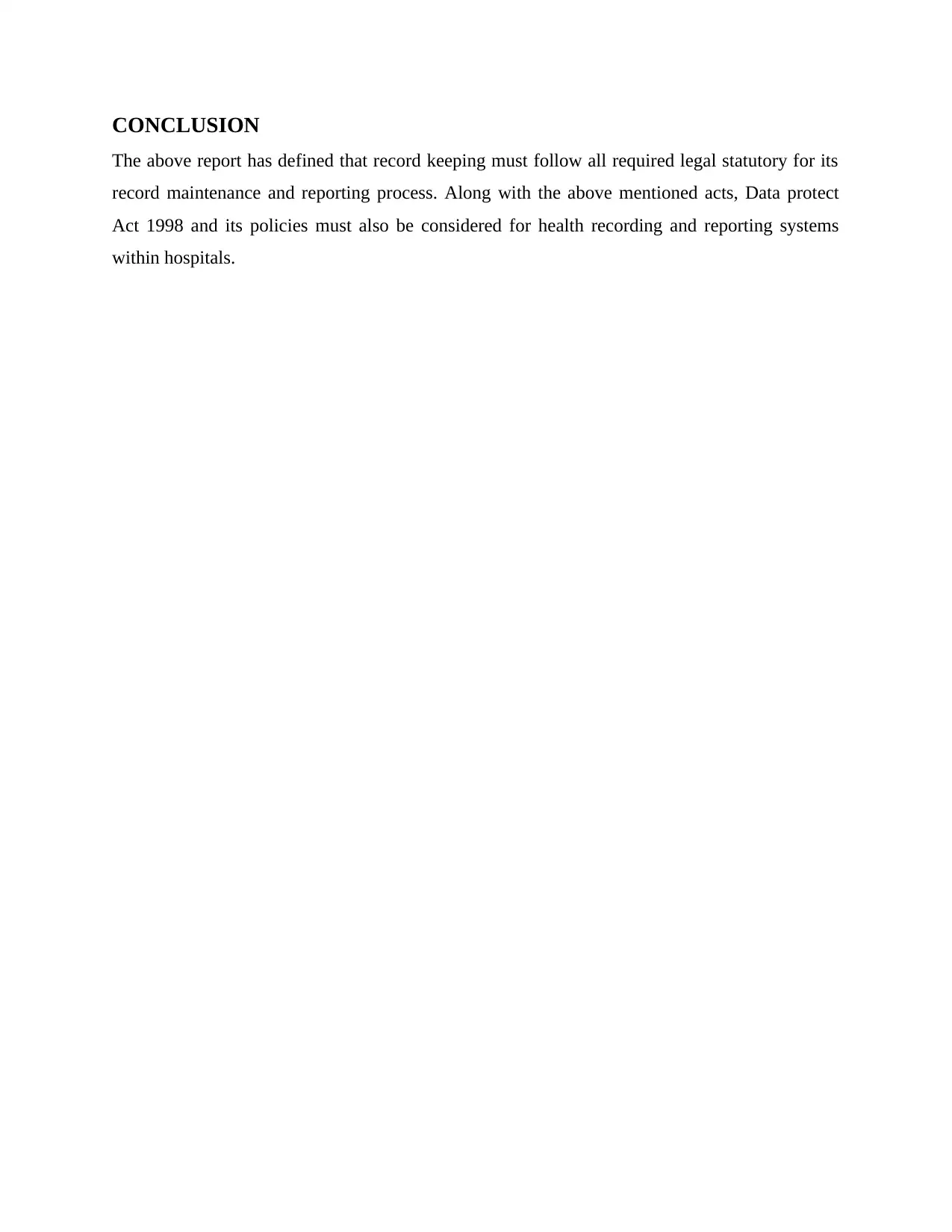
CONCLUSION
The above report has defined that record keeping must follow all required legal statutory for its
record maintenance and reporting process. Along with the above mentioned acts, Data protect
Act 1998 and its policies must also be considered for health recording and reporting systems
within hospitals.
The above report has defined that record keeping must follow all required legal statutory for its
record maintenance and reporting process. Along with the above mentioned acts, Data protect
Act 1998 and its policies must also be considered for health recording and reporting systems
within hospitals.
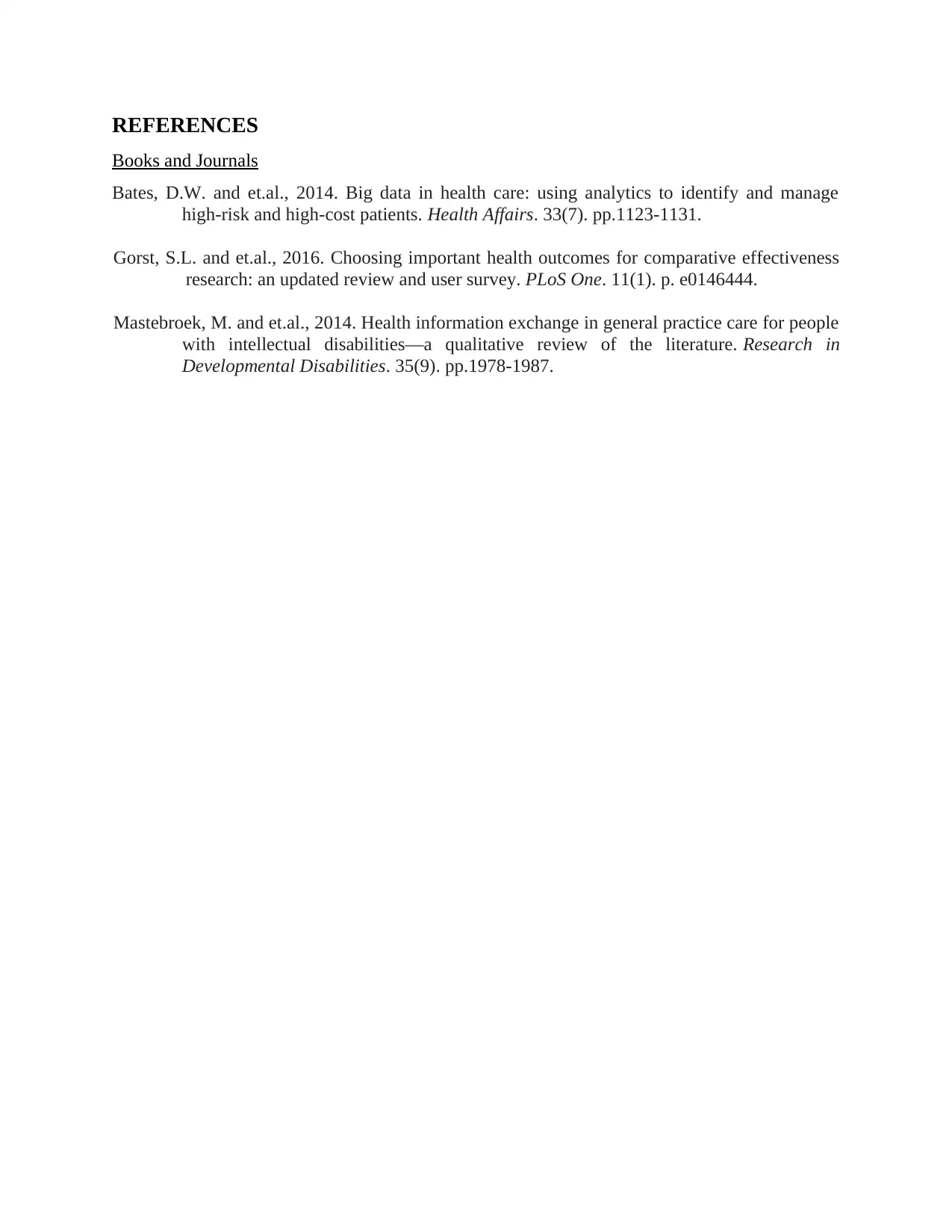
REFERENCES
Books and Journals
Bates, D.W. and et.al., 2014. Big data in health care: using analytics to identify and manage
high-risk and high-cost patients. Health Affairs. 33(7). pp.1123-1131.
Gorst, S.L. and et.al., 2016. Choosing important health outcomes for comparative effectiveness
research: an updated review and user survey. PLoS One. 11(1). p. e0146444.
Mastebroek, M. and et.al., 2014. Health information exchange in general practice care for people
with intellectual disabilities—a qualitative review of the literature. Research in
Developmental Disabilities. 35(9). pp.1978-1987.
Books and Journals
Bates, D.W. and et.al., 2014. Big data in health care: using analytics to identify and manage
high-risk and high-cost patients. Health Affairs. 33(7). pp.1123-1131.
Gorst, S.L. and et.al., 2016. Choosing important health outcomes for comparative effectiveness
research: an updated review and user survey. PLoS One. 11(1). p. e0146444.
Mastebroek, M. and et.al., 2014. Health information exchange in general practice care for people
with intellectual disabilities—a qualitative review of the literature. Research in
Developmental Disabilities. 35(9). pp.1978-1987.
⊘ This is a preview!⊘
Do you want full access?
Subscribe today to unlock all pages.

Trusted by 1+ million students worldwide

1 out of 7
Related Documents
Your All-in-One AI-Powered Toolkit for Academic Success.
+13062052269
info@desklib.com
Available 24*7 on WhatsApp / Email
![[object Object]](/_next/static/media/star-bottom.7253800d.svg)
Unlock your academic potential
Copyright © 2020–2025 A2Z Services. All Rights Reserved. Developed and managed by ZUCOL.




